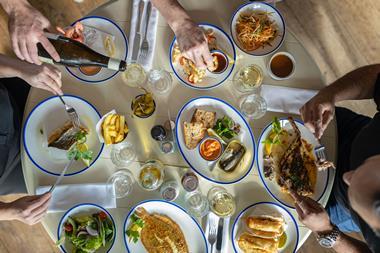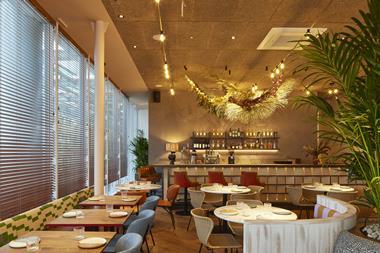Given the rapid pace of expansion over the past few years on the high street and in leisure parks of restaurant brands, many believe it is inevitable that there will be some casualties over the coming 18 months. After rapid expansion, 2016 was a turning point in terms of outlet growth rate. The fear is that the sector could possibly be returning to a 2002 or 2008-11 scenario, where a race for space – especially on the high street - led to a spate of closures - with the re-emergence of pre-packs looming large on the horizon. Mark Wingett discusses the prospects for the sector in 2017, with contributions from leading analyst Geof Collyer
It is a question that gets asked annually, but one that seems especially relevant as we get the first month of the year out of the way – is the UK’s eating and drinking-out marketing reaching saturation point? The message from some operators is no, there is still opportunity for expansion out there, but how much of it will be at the expense of others? However, the majority have spoken of biding their time this year in terms of openings, not afraid to wait for the right opportunity, keen to make sure their existing business is robust to survive the inevitable headwinds it will face or waiting for what they see as an over-heating property market to cool down.
When presenting his last full-year presentation for The Restaurant Group (TRG) in March last year, the company’s then chief executive Danny Breithaupt used one slide to highlight the size of the UK’s casual dining market as of February 2016. The table (slide 24 for those looking to check it out) showed that 375 sites had opened in the segment over the course of the previous 18 months, an 8% increase to just under 5,000 outlets.
Leading analyst Geof Collyer at Lavender Bank Partners says: “I think it is almost impossible for a company to add more than 15-20% to its scale in a year without some kind of a hiccup. Some of the groups that are on that slide have expanded by 30-100%. It’s a good place to start looking for potential casualties.”
In the past six months, we have seen a number of group’s row back a bit in terms of expansion, another in Ed’s go into administration, with the new owners seeking to close around half of the estate. Collyer says: “Add in Mitchells & Butlers (M&B) - it’s 75 pubs up for sale plus its 2016 and 2015 disposals are equivalent to half of the Orchid estate in numbers - and TRG, as we know, looking to sell off around 7% of its sites, and the net widens. At least we know about these groups. But with rates, NLW, cost inflation and economic uncertainty of 2008-9 proportions coming - maybe worse - there have to be more casualties.
“People always forget that financial and operational gearing can work in reverse, and in the last downturn (2008-11), it was high street leasehold sites that caused the problems, not freeholds - which suggests that the freehold pub groups may do a lot better than the restaurants.
“So I think that there will be some who have jumped on the bandwagon who will get badly burned. Each week, yet another ‘brand’ is launched to industry fanfare. But many seem to think that opening in Soho and Shoreditch is hitting pay dirt. When the format works in Sunderland or Sheffield, then maybe.”
Collyer appoints out TRG in regards to disposals, and Jamie’s Italian can also be added in, but other groups are also currently quietly going about pruning their estates. The issue is whether there are buyers out there for the majority of sites that are entering an already cautious market?
According to MCA’s soon to be available Top of Mind survey, which questions the leading sector executives about their predictions for the state of the market, outlet growth across the sector fell from 6.5% in 2015 to 3.9% last year, with the rate of growth forecast to fall again this year to c3.7%, which highlights that brands are slowing down their expansion plans, mixed with closures from less favoured brands – Frankie & Benny’s, Ed’s and Fayre & Square to name three.
The report found that net growth is still resilient, with 521 net new outlets set to open this year, c10 per week, but down from c16 opening per week in 2015. South East Asian is set to be the fastest growing cuisine in 2017 by percentage growth, but Italian still makes up 1 in 10 of new openings this year.
So there is set to be growth, but will there be the level of growth to match the level of closures and will there be an appetite from up-and-coming operators and those still pushing forward with expansion plans to fill in the gaps that will inevitably appear in schemes and high streets? Take retail parks and TRG, over the last five years and more, a landlord could guarantee that out of five units, two if not three would be taken up by Frankie & Benny’s, Coast to Coast or Chiquito. That guarantee isn’t there anymore. Casual Dining Group has taken up some that slack with its previously aggressive roll out of Bella Italia, but is set to put its “foot on the ball” when it comes to that brand over the coming year. Who will fill in that gap? Byron or Wahaca? I very much doubt it.
Then there are the major developments and inner city/town schemes, planned years ago with operators lined up, but now facing a changing environment and those same operators getting cold feet – circling developments waiting for their peers to jump in first before committing themselves, fearing one marginal site decision could reverse years of good work. Landlords/developers have for the last few years seen F&B as the golden goose for rejuvenating high street locations and retail schemes, but what if economic environment coupled with their own unwillingness to recalibrate rental levels led them to cook their own goose, could we start to see more sites shuttered? Rent free periods have been pushed out to attract new operators but yet rental levels are still on the rise, surely that has to change by the end of this year.
In 2007, sector expert Peter Hansen, then a partner at advisory firm PC Hansen, highlighted in our sister title the MA, that in its 2000 annual report, the chairman of Yates’s Wine Lodges stated: “I am pleased to be able to report further substantial progress for the group during the year. A record number of new branches have been opened, including the 100th Yates’s Wine Lodge.” Hansen wrote that twelve months later, the message in the 2001 annual report was very different: “Over the past two years trading conditions have become more competitive, due to proliferation of similar venues… Whilst the market is still growing, the level of new capital investment from existing players and new entrants has produced over-capacity in a number of major towns and cities.”
Most wounds in life tend to be self-inflicted – and those warning signs are starting to re-appear – let’s hope they are heeded in time.











































